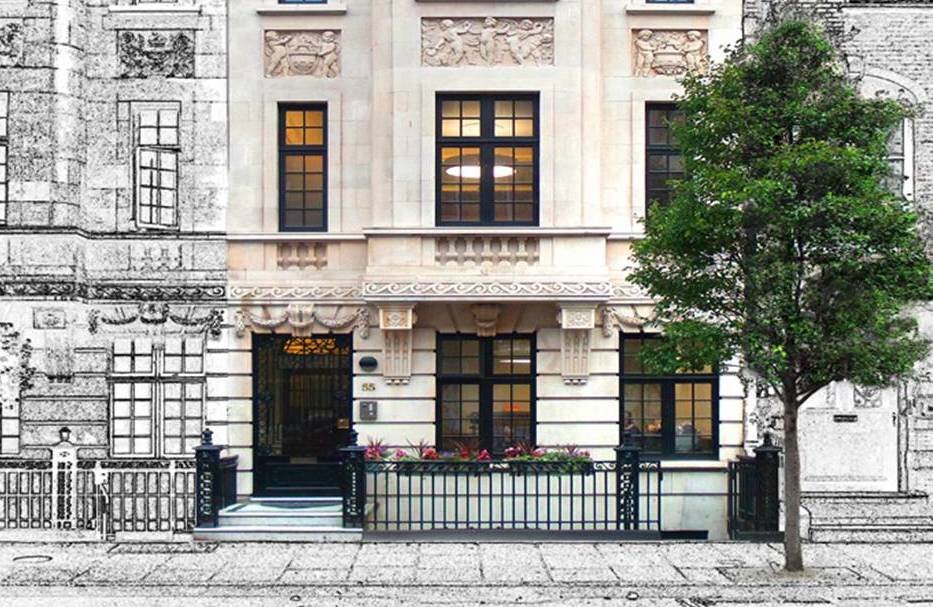Patch tests for allergy
Skin Patch test panels applied on the back
Patch testing is used by dermatologists to determine whether your skin condition is caused by an allergy to substances in direct contact with your skin (contact dermatitis).
It does not detect reactions related to diet or inhalation which might produce sneezing, asthma or hives. Skin prick tests and detection fo specific IgE antibodies in the blood are used for this.
Patch testing requires 3 appointments over 1 week. You must attend all 3 appointments on the specified days.
Please note: the current wait for patch tests is 4 months
Initial appointment - day 1 (Thursday)
Dr Ian White leads the testing clinic here at Skin55. He will go through your history and determine which substances (allergens) you need to be tested with. During this initial consultation a pre-test diagnosis will be formulated.
In the tests, you will be exposed to around 40 standard substances commonly in contact with the skin, eg rubber, chemicals, metals, perfumes and plants, and also additional substances relevant to your problem. You may be tested to some of your own work or home products.
Following your consultation, Dr White will inform the specialist nurse which allergens you need to be tested for and they will prepare the patches. Some of your own products, if to be tested, may need to be diluted first.
A series of small chambers (patches) containing the allergens are applied to your back under adhesive tape by the patch test nurse who will also talk your through the procedure and answer any additional questions you may have. The back is usually used as a convenient site but occasionally the tests may be on the ipper arms or elsewhere if your back has active eczema at the time of testing or all the test chambers cannot be fitted onto the upper back.
A photograph is taken of your back, if you consent, with your own phone, to record the test application site.
Removal of patches - day 3 (Saturday)
The chambers remain in place for 2 days before removal. You will do this yourself at home. Please remove tapes from your back and ask a family member or friend to take a photograph of the area with your own phone.
First reading - Day 5 (Monday)
You will return to clinic for the first reading/observations with the specialist nurse. They will assess the areas and also use your photos taken on the previous day to determine whether any reactions are present. If there is a doubtful reaction, a test may need to be repeated. You may be asked to rub one or more of your cosmetic producted onto the skin beloew your elbow creas serveral times a day for a a few days if there is a doubtful reaction on the test to the product. This is called a ‘repeated open application test’ and mimics and exaggerate real-life exposure.
Second reading - day 8 (Thursday)
On day 8, a second reading is made and a third photograph taken. After the second reading is completed, Dr White will discuss the results with you and explain the post-patch test diagnosis.
Following the tests, you may bathe or shower normally. Any staining of the skin will go within a few days. Any positive reaction will normally settle over a few days but can be longer, a topical steroid may be used to speed up resolution.
A letter will be sent to the referring dermatologist and copied to yourself with details of the tests, results and interpretation.
Pre-patch test advice
You are advised to wear an old shirt, vest, blouse or T-shirt during testing as it is possible a small amount of the test substances, skin marking ink and petrolatum (used to dilute the allergens) may stain!
DO NOT apply any creams or moisturisers on your back for a day before the tests.
If your back is very hairy, please shave or clip the hairs away at least a week before your first appointment.
If you are on prednisolone tablets (more than 15mg daily), please contact the clinic before your appointment, in case the tests need to be delayed. This may also apply for other medicines that suppress the immune system (e.g. methotrexate, azathioprine, ciclosporin etc).
Dos and Don’ts
Don’t
Get your back wet during the tests. You can sit in the bath and shower the front but your back should be kept dry.
Participate in activities that may dislodge the tests by excessive sweating or stretching.
Apply cream or ointment to your back as the patches will slide off.
Due to potential staining, do not wear a new or valuable shirt, vest, blouse or bra.
Do
Contact us with any problems.
Remove the tests if they cause intolerable itching or discomfort.
Apply additional tape if the tests appear to becoming loose.
Wear night clothes to protect the tests.
Please note
You may continue to take antihistamines during the tests.
As policy, in Europe patch testing is not performed on women who are known to be pregnant. This exclusion is purely for medico-legal reasons; there is no scientific basis for this.
Children can be tested. For practical reasons, a restricted but aimed series of test substances may be applied.
Are there any complications?
Any positive reaction is usually no more than a 1 cm square red patch. However, very allergic individuals may develop vesicles (small blisters) or spread of the reaction to the surrounding skin. If this happens, a potent topical steroid cream will be applied to settle the reaction (an acute dermatitis).
Uncommonly, a delayed reaction may develop some days after the tests. If this happens, please let us know.
Pigmentary variegation (post-inflammatory hyper and hypo pigmentation) rarely occurs at the site of a marked reaction in darker skin types. Any changes will settle in due course.
Patch testing with Dr Ian White costs £600




